Princess of Wales
Princess of Wales (Welsh: Tywysoges Cymru) is a courtesy title used since the 14th century by the wife of the prince of Wales, a title reserved for the heir apparent to the English and later British throne. Female heirs to the throne (apparent or presumptive) have not formally held the title.[1] The current title-holder is Catherine (née Middleton).
| Princess of Wales | |
|---|---|
| Tywysoges Cymru | |
| Style | Her Royal Highness |
| Member of | British royal family |
| First holder |
|
The title was first recorded in an independent Wales when it was held by Eleanor de Montfort, the wife of the native prince of Wales, Llywelyn ap Gruffydd.
Background
Prior to 'Princess' (Welsh: Tywysoges) the title of 'Queen' (Welsh: Brenhines) was used by some spouses of the rulers of Wales. Examples are Angharad ferch Owain, wife of Gruffudd ap Cynan, and Cristin verch Goronwy, wife of Gruffudd's son, Owain Gwynedd (specifically, she was known as 'Queen Dowager').[2]
The title in independent Wales
Joan (Siwan)
Joan, also known as Siwan (her Welsh name), was the illegitimate daughter of King John of England. She was the wife of Llywelyn the Great (initially king of Gwynedd), effective ruler of all of Wales.[3] During her tenure, she used the titles 'Lady of Wales' and 'Lady of Snowdon'.
Eleanor de Montfort and Gwenllian
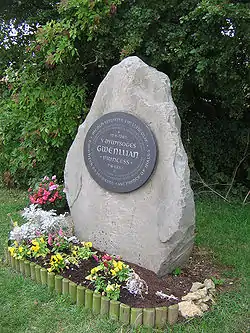
Following her wedding ceremony in 1278, Eleanor de Montfort was officially known as princess of Wales.[5][6][7][8] On 19 June 1282, she died giving birth to her first child, Gwenllian.[9]
The infant was captured by English forces the following year, after her father, Llywelyn ap Gruffydd, was killed in December 1282. At Edward I's orders, she was kept in the remote Sempringham Priory in Lincolnshire, where she remained until her death in 1337.
Gwenllian's status was acknowledged at least once by the English Crown. When writing to the pope, attempting to secure more money for Sempringham Priory, the king stated that "...herein is kept the Princess of Wales, whom we have to maintain". The title 'Princess of Wales' as used here did not have its usual accepted meaning.[10][4]
Margaret Hanmer and Catrin, daughter of Glyndŵr
Margaret Hanmer, sometimes known as Marred ferch Dafydd (her Welsh name), was the wife of Owain Glyndŵr.[11][12] Some modern historians have accorded her the title 'Princess of Wales'.[13]
Catrin was one of the children of Owain Glyndŵr and Margaret Hanmer. In November 1402, she married Sir Edmund Mortimer, the second son of Edmund Mortimer, 3rd Earl of March and through his mother, a great-grandson of Edward III of England.[14]
Edmund Mortimer died during the siege of Harlech Castle in 1409, of unknown causes.[15] Catrin was subsequently captured alongside her three daughters, and they were taken to the Tower of London, along with Catrin's mother and one of her sisters. The deaths and burials of Catrin and her daughters are recorded, but the causes of their deaths remain unknown. They were laid to rest at St Swithin's Church in London.[16]
List
| Image | Name | Birth | Spouse | Death | Notes |
|---|---|---|---|---|---|
 |
Joan, Lady of Wales | 1191 | Llywelyn the Great | 2 February 1237 | Known as Siwan in Welsh; Lady of Wales and Snowdon;[17] Proposed to have been Princess of Wales[18] |
| Isabella de Braose | 1222 | Dafydd ap Llywelyn | 1248 | Proposed to have been Princess of Wales[19] | |
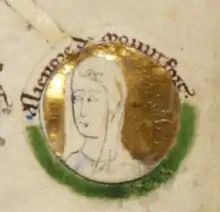 |
Eleanor de Montfort | 1252 | Llywelyn ap Gruffydd | 19 June 1282 | Princess of Wales; Lady of Snowdon[20][21][22] |
 |
Elizabeth Ferrers | 1250 | Dafydd ap Gruffydd | 1300 | Proposed to have been Princess of Wales |
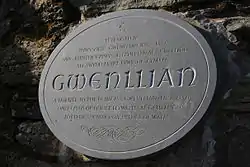 |
Gwenllian of Wales | June 1282 | 7 June 1337 | Princess of Wales;[10] daughter of Llywelyn ap Gruffydd | |
 |
Margaret Hanmer | 1370 | Owain Glyndŵr | 1420 | Later attributed[23] |
 |
Catrin ferch Owain Glyndŵr | Edmund Mortimer | 1413 | Proposed to have been Princess of Wales; daughter of Owain Glyndŵr[24] |
Spouse of the British (formerly English) heir apparent
Cecily Neville, wife of Richard, 3rd Duke of York, is omitted from this list. While her husband was briefly given various titles, including prince of Wales, by an Act of Parliament as part of his arrangement to succeed Henry VI, he is not generally recognised as such and is not mentioned in any published summary of the topic.
Although not granted the title in her own right, the future Mary I was, during her youth, invested by her father, Henry VIII, with many of the rights and properties traditionally given to the prince of Wales, including the use of the official seal of Wales for correspondence. For most of her childhood, Mary was her father's only legitimate child, and for this reason, she was often referred to as the princess of Wales, although Henry never formally created her as such. For example, contemporary scholar Juan Luis Vives dedicated his Satellitium Animi to "Dominæ Mariæ Cambriæ Principi, Henrici Octavi Angliæ Regis Filiæ" ("To the Lady Mary, Prince of Wales, Daughter of Henry VIII, King of England").[25]
Welsh politicians suggested that George VI's elder daughter, Princess Elizabeth (the future Elizabeth II), be granted the title on her 18th birthday, but he rejected the idea because he felt such a title belonged solely to the wife of a prince of Wales and the prince of Wales had always been the heir apparent.[1]
Camilla, Charles III's second wife, was the princess of Wales from 2005 to 2022, but did not use the title due to its popular association with her husband's first wife, Diana.[26]
On 9 September 2022, a day after his accession to the throne, Charles III bestowed the title of 'Prince of Wales' upon his elder son, Prince William, hence making his wife, Catherine, the new princess of Wales.[27]
List
| Person | Previous name | Birth | Marriage | Became Princess of Wales | Spouse | Change in style | Death | Notes |
|---|---|---|---|---|---|---|---|---|
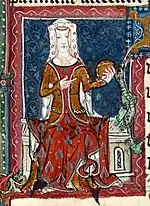 |
Joan of Kent | 19 September 1328 | 10 October 1361 | Edward of Woodstock | 7 June 1376 Husband's death; became Dowager Princess of Wales |
7 August 1385 | ||
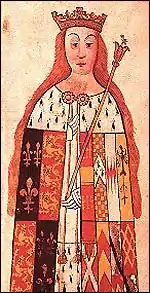 |
Anne Neville | 11 June 1456 | 13 December 1470 | Edward of Westminster | 4 May 1471 Husband's death; became Dowager Princess of Wales |
16 March 1485 | Later became queen consort as the wife of Richard III | |
 |
Catherine of Aragon | 16 December 1485 | 19 May 1499 (by proxy) 14 November 1501 |
Arthur Tudor | 2 April 1502 Husband's death; became Dowager Princess of Wales |
7 January 1536 | Later became queen consort as the wife of Henry VIII | |
 |
Wilhelmina Charlotte Caroline of Brandenburg-Ansbach | 1 March 1683 | 22 August 1705 | 27 September 1714 | George Augustus | 11 June 1727 Husband acceded to throne as George II; became queen consort |
20 November 1737 | |
 |
Augusta of Saxe-Gotha-Altenburg | 30 November 1719 | 17 April 1736 | Frederick Louis | 31 March 1751 Husband's death; became Dowager Princess of Wales |
8 February 1772 | ||
 |
Caroline Amelia Elizabeth of Brunswick-Wolfenbüttel | 17 May 1768 | 8 April 1795 | George Augustus Frederick | 29 January 1820 Husband acceded to throne as George IV; became queen consort |
7 August 1821 | ||
 |
Alexandra Caroline Marie Charlotte Louise Julia of Denmark | 1 December 1844 | 10 March 1863 | Albert Edward | 22 January 1901 Husband acceded to throne as Edward VII; became queen consort |
20 November 1925 | ||
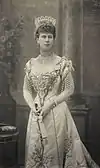 |
Victoria Mary Augusta Louise Olga Pauline Claudine Agnes of Teck | 26 May 1867 | 6 July 1893 | 9 November 1901 | George Frederick Ernest Albert | 6 May 1910 Husband acceded to throne as George V; became queen consort |
24 March 1953 | |
 |
Diana Frances Spencer | 1 July 1961 | 29 July 1981 | Charles Philip Arthur George | 28 August 1996 Divorced; assumed the style of Diana, Princess of Wales |
31 August 1997 | ||
.jpg.webp) |
Camilla Rosemary Shand[28] | 17 July 1947 | 9 April 2005 | 8 September 2022 Husband acceded to throne as Charles III; became queen consort |
living | Known as Duchess of Cornwall during her tenure | ||
03.JPG.webp) |
Catherine Elizabeth Middleton[29] | 9 January 1982 | 29 April 2011 | 9 September 2022 | William Arthur Philip Louis | Incumbent | living | |
See also
- Controversy of the Prince of Wales title
- The Green Howards (Alexandra, Princess of Wales's Own Yorkshire Regiment)
- The Princess of Wales' Own Regiment (Canada)
Notes
- Pimlott, Ben (2001). The Queen: Elizabeth II and the monarchy (Golden Jubilee ed.). London: HarperCollins. ISBN 0-00-711435-4. OCLC 59496079.
- Messer, Danna R. (30 September 2020). Joan, Lady of Wales: Power and Politics of King John's Daughter. Pen and Sword History. ISBN 978-1-5267-2932-3. Archived from the original on 13 January 2023. Retrieved 23 October 2022.
- Kate Norgate and A. D. Carr: "Joan [Siwan", Oxford Dictionary of National Biography (Oxford: OUP, 2004), Retrieved 2 February 2019.]
- "Gwenllian The Lost Princess of Wales". Historic UK. Archived from the original on 23 March 2022. Retrieved 11 September 2022.
- Bliss, W. H., editor. Calendar of Papal Registers Relating To Great Britain and Ireland: Volume 1, 1198-1304. Her Majesty's Stationery Office, London, 1893.
- Calendar of Patent Rolls, 1272–81, 306; CPR, 1281–92, 11
- Calendar of Ancient Correspondence, 75-76
- Foedera I, ii, 576, 584, 587
- The chronicle of Bury St Edmunds, p.74-76
- Fisher, Deborah (2005). Princesses of Wales. University of Wales Press. pp. viii–ix. ISBN 9780708319369.
- The History of the Princes, the Lords Marcher, and the Ancient Nobility of Powys Fadog. 1. London: T. Richards. pp. 199, 211–219. The History of the Princes, the Lords Marcher, and the Ancient Nobility of Powys Fadog. 1. London: T. Richards. pp. 199, 211–219.
- "Owain Glyndwr - The Parish of Hanmer and Tallarn Green". parish.churchinwales.org.uk. Archived from the original on 5 October 2022. Retrieved 12 June 2019.
- Deborah Fisher, Princesses of Wales (University of Wales Press, 2005)
- Gwynfor Evans (1974). Land of my fathers: 2000 years of Welsh history. John Penry Press. ISBN 9780903701037. Archived from the original on 13 January 2023. Retrieved 5 October 2022.
- The Last Mab Darogan, Charles Parry (Novasys, 2010) pp. 273–4.
- Issues of the Exchequer, Hen. III – Hen. VI, ed. F Devon (Record Commission, 1837), p. 327
- Messer, Danna R. (30 September 2020). Joan, Lady of Wales: Power and Politics of King John's Daughter. Pen and Sword History. p. 172. ISBN 978-1-5267-2932-3.
- Sims-Williams, Patrick (25 November 2010). Irish Influence on Medieval Welsh Literature. OUP Oxford. p. 297. ISBN 978-0-19-159159-4. Archived from the original on 13 January 2023. Retrieved 23 October 2022.
- Fisher, Deborah C. (2005). Princesses of Wales. University of Wales Press. p. 6. ISBN 978-0-7083-1936-9. Archived from the original on 13 January 2023. Retrieved 23 October 2022.
- Calendar of Patent Rolls, 1272–81, 306; CPR, 1281–92, 11
- Calendar of Ancient Correspondence, 75-76
- Foedera I, ii, 576, 584, 587
- Deborah Fisher, Princesses of Wales (University of Wales Press, 2005)
- Issues of the Exchequer, Hen. III – Hen. VI, ed. F Devon (Record Commission, 1837), p. 327
- Vives, Juan Luis (1883). Satellitium animi (in Latin). Apud A. Pichleri viduam et filium. Archived from the original on 13 January 2023. Retrieved 8 October 2022.
- "House of Commons – Royal Marriage". parliament.uk. Archived from the original on 26 June 2009. Retrieved 7 February 2015.
- RegalFille (9 September 2022). "The New Prince and Princess of Wales". RegalFille. Retrieved 23 January 2023.
- Chris Leslie, Parliamentary Secretary, Department for Constitutional Affairs (4 April 2005). "Royal Marriage". Parliamentary Debates (Hansard). United Kingdom: House of Commons. col. 1228W. "Archived copy". Archived from the original on 26 June 2009. Retrieved 8 September 2017.
{{cite web}}: CS1 maint: archived copy as title (link) CS1 maint: bot: original URL status unknown (link) - "King Charles III pays tribute to his 'darling mama' in first address". BBC.com. 9 September 2022. Archived from the original on 12 September 2022. Retrieved 11 September 2022.
Bibliography
Further reading
- Fryer, M.; Mary Beacock Fryer; Arthur Bousfield; Garry Toffoli (1983). Lives of the Princesses of Wales. Toronto: Dundern Press Limited. ISBN 978-0-919670-69-3.